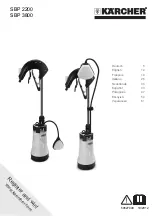
ERYQ005~007ACV3
Outdoor unit for air to water heat pump
3P194375-1A
(4PW33166-1B)
Installation manual
6
6
Turn the liquid stop valve's rod 90 degrees counterclockwise
with a hexagonal wrench to open the valve.
Close it after 5 seconds, and check for gas leakage.
Using soapy water, check for gas leakage from the indoor unit's
flare and the outdoor unit's flare and the valve rods.
After the check is complete, wipe all soapy water off.
7
Disconnect the charging hose from the gas stop valve's service
port, then fully open the liquid and gas stop valves.
Do not attempt to turn the valve rod beyond its stop.
8
Tighten the valve lids and service port caps for the liquid and
gas stop valves with a torque wrench at the specified torques.
See
"Connecting the refrigerant piping to the outdoor unit" on
for details.
Charging refrigerant
This outdoor unit is factory charged.
Important information regarding the refrigerant used
This product contains fluorinated greenhouse gases covered by the
Kyoto Protocol. Do not vent gases into the atmosphere.
Refrigerant type:
R410A
GWP
(1)
value:
1975
(1)
GWP = global warming potential
Please fill in with indelible ink,
■
➀
the factory refrigerant charge of the product,
■
➁
the additional refrigerant amount charged in the field and
■
➀
+
➁
the total refrigerant charge
on the refrigerant charge label supplied with the product.
The filled out label must be adhered in the proximity of the product
charging port (e.g. onto the inside of the service cover).
Re-charging
In case re-charging is required, refer to the nameplate of the unit. The
nameplate states the type of refrigerant and necessary amount.
Charging additional refrigerant
If the total length of refrigerant piping exceeds 10 m in length,
additionally charge with 20
g of refrigerant (R410A) for each
additional meter of piping.
Determine the weight of refrigerant to be charged additionally and fill
in the amount in the service sticker on the rear side of the stop valve
cover.
Precautions when adding R410A
■
Be sure to charge the specified amount of refrigerant in liquid
state to the liquid pipe.
Since this refrigerant is a mixed refrigerant, adding it in gas form
may cause the refrigerant composition to change, preventing
normal operation.
■
Before charging, check whether the refrigerant cylinder is
equipped with a siphon tube or not (the cylinder should be
marked with "liquid filling siphon attached" or something similar).
■
Be sure to use tools exclusively for R410A to ensure required
pressure resistance and to prevent foreign materials from mixing
into the system.
Wiring
3
5
6
2
1
4
1
factory refrigerant charge
of the product:
see unit name plate
2
additional refrigerant
amount charged in the
field
3
total refrigerant charge
4
Contains fluorinated
greenhouse gases
covered by the Kyoto
Protocol
5
outdoor unit
6
refrigerant cylinder and
manifold for charging
Charge the liquid
refrigerant with the
cylinder in upright
position.
Charge the liquid
refrigerant with the
cylinder in up-side-down
position.
WARNING
■
All wiring must be performed by an authorized
electrician.
■
The power supply cable and circuit breaker must be
selected in accordance with local and national
regulations.
■
Do not use tapped wires, stranded conductor wires
(see caution 1 under
extension cords, or connections from a star system,
as they may cause overheating, electrical shock or
fire.
■
Do not use locally purchased electrical parts inside
the product and do not branch the power for the
heater tape, etc., from the terminal block. Doing this
may cause electrical shock or fire.
■
Be sure to install an earth leakage circuit breaker.
This unit uses an inverter, which means that an earth
leakage circuit breaker capable of handling high
harmonics needs to be used in order to prevent
malfunctioning of the earth leakage circuit breaker
itself.
■
Use an all-pole disconnection type breaker with a
contact separation of at least 3 mm inbetween all
poles.
WARNING
Do not turn ON the safety breaker until all work is
completed.




























